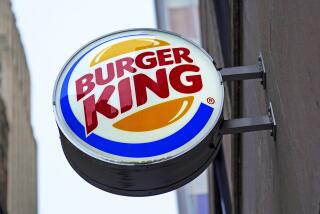Don’t Be Fooled by Claims --Check Nutrition Label
- Share via
Food labels are supposed to make healthful choices easier, showing the differences among products on supermarket shelves. In reality, they can sometimes add to your confusion.
The U.S. Food and Drug Administration requires most foods to carry a “Nutrition Facts” label, which not only tells you how many calories the food has per serving, but also the amount of fat, proteins, carbohydrates, fiber, vitamins and minerals. Typically, this label is printed on the back or side of the package.
The agency also imposes strict limitations on the marketing claims that manufacturers can place anywhere on their packages. Even the meaning of specific words is controlled. For example, when a manufacturer uses the words “no” or “free” on a package--as in “no fat” or “cholesterol-free”--the food must contain none, or only a trivial amount, of the nutrient described. By law, a fat-free product must contain less than half a gram of fat per serving; “calorie-free” products must contain fewer than 5 calories in a serving.
In spite of these regulations, many claims on food packages seem, at best, confusing and, at worst, downright misleading. What’s the harm? Someone who is trying to lower his or her cholesterol could end up with a high-fat product despite a “reduced fat” label; a person attempting to lose weight might end up with a “light” product that is highly caloric. The problem is well illustrated by the following examples, which we found during a recent trip through a Los Angeles supermarket.
Under the regulations, a “light” product must contain at least one-third fewer calories or half the fat of the product with which it is being compared. When we compared one brand of “light” chocolate ice cream to its “regular” counterpart, the “light” product did contain 50% less fat than the “regular” (3 grams compared with 6). However, the two products didn’t differ much calorically: A serving of “light” ice cream was only 10 calories lighter than a portion of the regular (140 compared with 150). The same was true of Jolly Time “Butter-Licious” popcorn. The “original” version contains 140 calories and 9 grams of fat per unpopped serving; the “light” popcorn delivers 120 calories and 6 grams of fat. And a tablespoon of Blue Bonnet “light” margarine is indeed lower in calories than Blue Bonnet “regular” (50 versus 80), but nonetheless, 100% of the calories are from fat--and there’s nothing light about that.
“Reduced” is another term that can be misleading. “Reduced-fat,” for example, does not necessarily mean low in fat, and “reduced-calorie” does not guarantee that a food is low in calories. For example: Skippy Reduced-Fat Peanut Butter does have 25% less fat than regular Skippy but still derives more than half its total calories from fat (one serving--just two tablespoons--contains 12 grams fat, or almost 20% of the average recommended daily intake). A serving of Reduced-Fat Kraft Singles gets 60% of its calories from fat.
Other terms to be cautious about include “fewer” or “less.” These are relative terms and should always lead you to ask: “Fewer or less than what?” Farmer John sells sausage patties that are 30% less fat than regular sausages: However, just one serving still contains 100 calories, 70 of which come from fat.
Even seemingly absolute terms such as “free” or “no” can be deceiving. A product that is “sugar-free” may still be highly caloric: One serving of Mothers Sugar-Free Shortbread Cookies, for example, contains 160 calories, half of which come from fat. And a food that contains “no cholesterol” could still be high in fat if it’s made with lots of vegetable oil.
Also, standardized terms are sometimes used in unorthodox ways on food packaging. For example, meat labeled as “lean” is restricted in the amount of fat and cholesterol it can contain; meat described as “70% lean” may contain significantly more. (One package of ground beef we saw in the supermarket was labeled as 70% lean; it contained 34 grams of total fat per serving and derived almost 80% of total calories from fat.)
Sometimes it’s not the claims on the box you need to worry about; it’s the names of the products themselves.
Based solely on the name, a consumer might assume that Nabisco’s “Vegetable Thins” Baked Snack Crackers were relatively low in fat and vitamin-rich. Not so. These crackers may be baked, but half their calories come from fat. And, although they do contain carrots, cabbage, peppers, and tomatoes, a review of the nutrition label shows that there is more shortening than vegetables.
So, how do you keep from falling for these legal--but misleading--claims and names? The simple answer: Don’t put anything into your shopping cart before reading the “Nutrition Facts” food label on the package. Use this label to help you select foods that are reasonably low in calories and fat. Also, use the label to find foods that are rich in vitamins, minerals and dietary fiber and low in saturated fat, cholesterol and sodium.
Reading these labels may prolong your shopping by a few minutes but will help you make better decisions about the foods you put in your body.
*
Dr. Jonathan Fielding is the director of public health and the health officer for the Los Angeles County Department of Health Services. Dr. Valerie Ulene is a board-certified specialist in preventive medicine practicing in Los Angeles. Their column appears the second and fourth Mondays of the month. Send questions by e-mail to ourhealth@dhs.co.la.ca.us. They cannot respond to every query.


